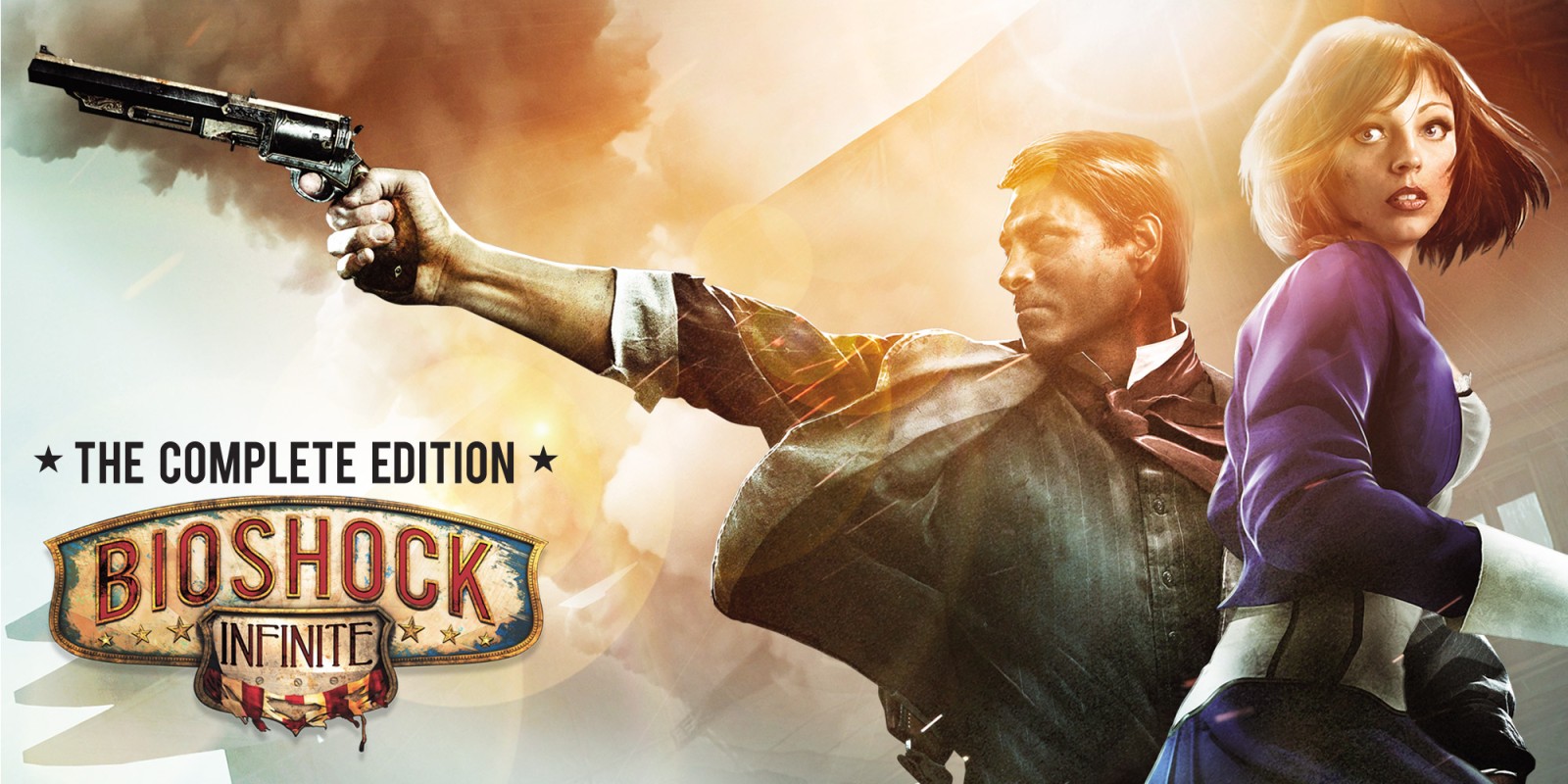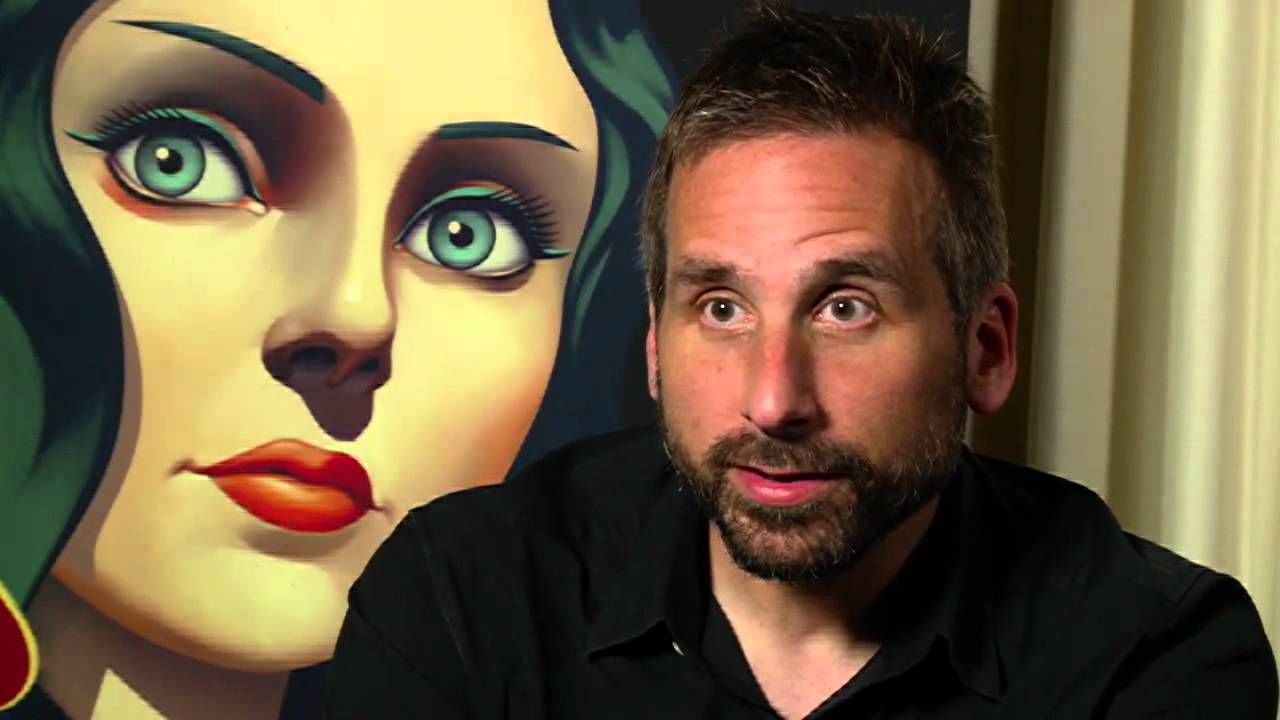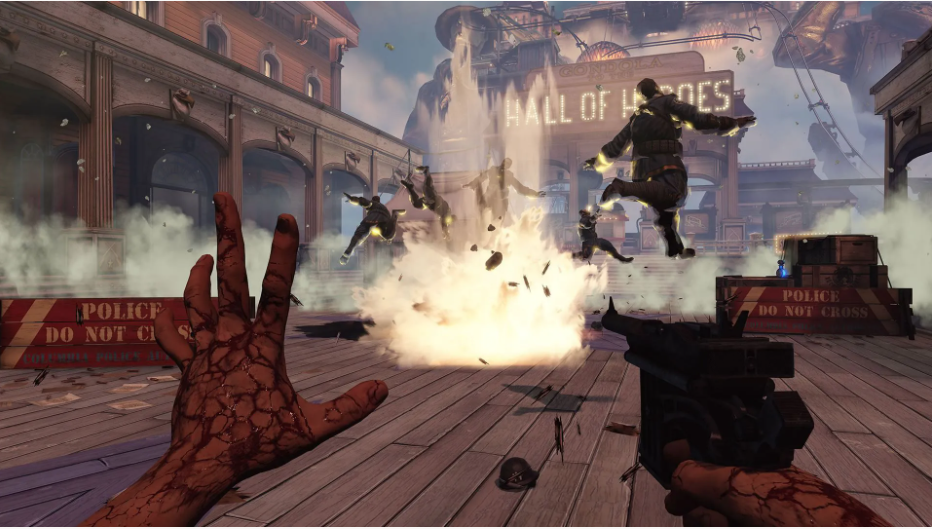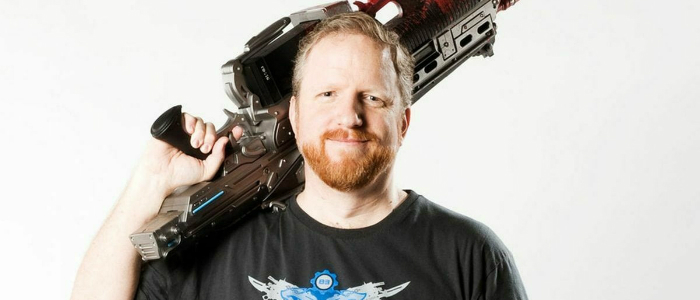
Press Reset , one of the most anticipated books on the gaming industry, is on sale today . Its author, renowned journalist Jason Schreyer (“Blood, Sweat and Pixels”), analyzes in detail the situations that led to the closure of successful studios and famous projects. Polygon has published an excerpt from the book on the circumstances of the creation of the legendary game BioShock Infinite. Under the cut - translation of the publication.
August 12, 2010, New York, the plush Plaza hotel near Central Park. Journalists gathered for a press preview of the trailer for the new game from the BioShock series. The opening footage is a delightful gimmick: the camera captures the familiar look of Rapture's underwater city , then pulls back to show it's just an aquarium ... Goodbye Rapture and hello BioShock Infinite! As soon as the trailer ended, the main developer gave an outline to the press about the upcoming game. The action takes place in Columbia, the flying city and symbol of American exceptionalism, in July 1912. Starring Booker DeWitt, a former Pinkerton agent whose mission is to rescue a black-haired girl named Elizabeth. She is guarded in a high prison tower by a robot named Nightingale, who, by the way, can become an excellent mascot (and trademark merchandise) instead of all those Big Daddies .

The presentation was remarkable not only for the fact that the developers finally told what exactly they are working on. No less important - now there is a reason, a reason not to deviate from the details that the trailer announced. Columbia and Elizabeth must now stay in the game - there was no more opportunity to refuse them.
For Forrest Dowling, this turned out to be very useful. He joined Irrationalas a level designer just a month before the announcement of Bioshock Infinite. As a BioShock fan, Dowling was absolutely delighted with what was happening in the studio: three years had passed since the release, and it was all the more delightful for the new employee to see that the team was still committed to the fundamental ideas of the game. “I joined development just at a time when the studio was suddenly vaccinated against conceptual hesitation,” says Dowling. "It is unlikely that now in the game it will be possible to change the scene, time, setting and conflict."
Dowling is a large, bearded man of a pragmatic nature. He grew up in western New York, realizing he wanted to be an artist, but didn't know where to start. After high school I entered the College of Arts, where, according to him, “there is even no question that you might somehow need to earn your living,” and for some time experimented with crafts like casting and sculpture, until in the end he was not at all disappointed in this area. In his final year, he was already thinking about changing directions, falling in love with video games (like Deus Ex) and wondering how appropriate it would be to make them a source of income.
In the 1990s and early 2000s, one of the best ways to learn game development was to create fan-made mods that altered gameplay or visuals. Some made mods for fun, while others saw potential in them for future careers. So, in 2003, a group of modders for the popular Battlefield shooter series teamed up and founded Trauma Studios in New York . The event did not go unnoticed by the direct developers of Battlefield, DICE , which acquired the studio the following year and closed it down almost a year later. This, in turn, was taken advantage of by rival DICE, publisher THQ, who recruited ex-Trauma employees to Kaos Studios.
For Dowling, who was by then making mods for games like Half-Life trying to figure out game development, Kaos seemed like the right place to work. “A young studio of ex-modders who suddenly had a budget to develop an AAA game,” Forrest recalls. "They were looking for employees, and that's how an idiot like me got to them." Dowling could not afford an apartment in New York, so he lived with relatives in the center of New Jersey for several months, spending two hours every day on the road to Manhattan. He first worked on the shooter Frontlines: Fuel of War (released in 2008), and then on Homefront, a game set in a dystopian setting about the North Korean army's invasion of the United States.
But in 2010 THQ faced big challenges. The economic downturn hit the company hard, which had to cut costs and its own studios, including Kaos. So when an Irrational recruiter asked Dowling if he would be interested in working on a new BioShock, Dowling agreed without hesitation. After a telephone interview, he was tested for knowledge of level design, then there was another communication on the phone and, finally, an interview in Quincy, where he was asked about work and experience. “I had a dull self-confidence, and what was happening did not frighten at all, although in theory it should have. I thought I had passed the level design test, I liked the result, so I communicated without much fear. "
Before heading home, Forrest spoke to lead designer Bill Gardner, who took him aside and asked not to refuse the offer. The thought of what Kaos would have to face in the final year of Homefront's development was agonizing: "Leaving a project on the eve of completion, when people go into crunch mode, is not cool at all." But my intuition told me that something was going wrong in Kaos and that THQ would not last long. “BioShock Infinite, on the other hand, was just a huge game in my mind,” says Forrest. “I really liked it and seemed to me then one of the smartest games of the generation ... So I could not refuse to participate in it and stay in the team of the project, which, as I thought, had no future”. Dowling's intuition did not disappoint: a year later, Kaos studio was closed, and THQ went bankrupt.
Dowling joined Irrational a few weeks before the Plaza press show. At that time it was a team of people, though tired, but ready to gladly show the world the results of their work. It took many months to prepare the presentation, and now everyone felt better at the thought that the fundamental ideas and solutions were finally approved. That Colombia will remain the scene. That it will be 1912. That Booker would have to save Elizabeth. Now, Ken Levine won't have the opportunity to drop these fundamental ideas, which means that the project team won't have to give up all the work that has been done.

Ken Levin
But, of course, a lot has changed in the end. Over the next few months, work on BioShock Infinite was slow, even by Irrational standards, with frequent adjustments, changes, and restarts. The company grew and developed, but the game did not. Levin constantly gave instructions to redo the levels and locations, apparently relying solely on his own vision. And every time it hurt artists, level designers and programmers: watching the result of several weeks of your life and work go nowhere is a demoralizing thing. “It's hard when they cut out or radically change what employees have been working on for months. And at Irrational, this has happened many times, ”admits Dowling.
In order to convince the parent company 2K of the need to expand the staff to work on the game (which was getting bigger and more expensive every day), Irrational needed to figure out a way to make BioShock Infinite replayable and attractive to players even after the story. Two multiplayer modes are part of this plan. The 2K management had high hopes for them. However, both modes were poorly coordinated with each other, and work on the main campaign was significantly behind schedule, so Irrational took the plunge and turned off multiplayer, transferring all staff to work with the campaign. “You waste a lot of time, put your strength and soul into something that is then simply thrown away after a single meeting. You won't forget that, ”says Bill Gardner, who helped lead the multiplayer team.

The demo versions of BioShock Infinite, released in 2011, impressed fans of the game: they could see not only the citizens of Colombia, but also the magical abilities of Elizabeth, who could tear the fabric of reality and extract objects from parallel worlds (while much of the demo presented as and did not reach the release, which also indicates the unpredictable nature of development). But at the same time, the developers themselves were seriously worried that without radical measures the game would never be finished. Due to constant tweaks and Levin's management style, several top employees had already left the team, and Irrational continued to hire new ones to make up for the losses and put the game in some order.
In March 2012, veteran game dev Don Roy joined the company with experience releasing games under the wing of publishers such as Sony and Microsoft. He was shocked when he saw how bad things were. “I went there and realized that the game didn't actually exist. The work has been colossal, but nothing looks like a game yet. When asked if I can play the current build, I received a negative answer. I was told that I can use separate pieces, but there is no full-fledged game as such ”.
According to Roy, what was most striking in the studio was the disorganization. Inflating the Irrational staff (if in 2008 there were several dozen employees, by the end of 2012 - about two hundred, plus contractors and outsourcing companies) led to all sorts of problems with the production pipeline (technological development environment). Chaos reigned everywhere. “A lot of what we outsourced did not appear in the game, because the processes were not regulated. Employees asked to develop something, but when the result finally appeared, it turned out that everything had already changed and there was no more need for it. ”One of Roy's tasks was to organize the workflow so that the company did not waste time and money. .

Rod Fergusson
In the summer of 2012, Irrational managed to hire Rod Fergusson. Previously at Epic Games, he has earned a reputation in the gaming industry as a manager who can take all the necessary steps to release a game (“closer”). Fergusson examined the state of BioShock Infinite, made a list of the remaining tasks, and charted a timeline for completion (including the inevitable crunch, of course). As one Irrational employee put it, "Without Fergusson, this game wouldn't have come out."
According to eyewitnesses, Fergusson's ability to communicate correctly with Ken Levin was no less important than the schedule. “Ken is a genius creator, with all the pros and cons that come with it. Ken was a terrible leader, really terrible, and he felt it very well himself. He's primarily a creative person, not a leader, ”recalls Infinite developer Mike Snight. Since the release of the first BioShock, Levine has been the subject of intense scrutiny. “Genius” and “challenge” - these two words come to mind of anyone who has managed to work with him. As a game designer, he had a unique vision that gave rise to masterpieces such as BioShock. However, at the same time, Levin needed a lot of time to realize this vision, and it was often extremely difficult to correctly convey it to other employees.“This is by no means an insult, but I am sure that he is primarily an editor, not an author. Ken doesn’t handle clean slate situations well, and if he doesn’t know what he wants, it’s hard to work with him, ”says producer Joe Folstik. According to the recollections of the studio workers, disputes and skirmishes often arose between Levin and other leading employees, and it was often noticeable how nervous and screaming he was because ideas were not implemented as he imagined them. "He's great, but doesn't always know how to get his message across."Arguments and skirmishes often arose between Levin and other leading employees, and it was often noticeable how nervous and screaming he was because ideas were not implemented in the way he imagined them. "He's great, but doesn't always know how to get his message across."Arguments and squabbles often arose between Levin and other leading employees, and it was often noticeable how nervous and screaming he was because ideas were not implemented in the way he imagined them. "He's great, but doesn't always know how to get his message across."
Fergusson was able to find a common language with Levin. He figured out how he envisioned the future game, and managed to correctly convey this vision to the rest. As Don Roy says, “Rod did everything right. And Infinite turned out to be that way because Fergusson was able to convey to the production what was in Ken's head. "
In a 2013 interview, Ken Levine drew an analogy between designing and creating a statue: "The way I create a game is more like a sculpture." To get the desired result, you have to cut off all unnecessary things. Prior to game development, Levin worked with scripts in the theater and film industries, in which the mantra “to write is to rewrite” operates, and the first draft, as a rule, never reaches the screen. However, in the gaming industry, where scripting goes hand in hand with production, the constant rewriting is essentially wiping out months of other people's work. “Yes, he is creating an amazing game and trying to achieve more and more impact. But it’s one thing to do it on paper, and it’s completely different to do the same with real people, finances, emotions and commitments. ”
A few years later, at the London Eurogamer conference, Levine admitted: “In almost every game I worked on, there came a period when I realized that the time allotted for development was running out, and that's when I started production. You have been doing something for several years, and then suddenly you find out: “Lord, we have practically no time left!” - and this mobilizes to make all the necessary decisions. There is some kind of magic here - it’s like a gun is put to the head and you have to urgently decide: after all, all people tend to procrastinate and we all like to put things off until later. So in situations where you have to decide what to keep, what to cut, what to focus on, and what to polish, that's where the game is created. ”
This style of work evoked mixed and sometimes very contradictory feelings in Levin's colleagues. Level-up artist Chad LaClair says his skills have grown significantly through his work at Irrational. But on the other hand, BioShock Infinite turned out to be the most difficult project of his entire career. “There were periods when it seemed to me that it was impossible to demonstrate our game to the world in this form - there is still a lot, very much to be done”. Like the rest of Irrational employees, at the final stage of development at the end of 2012 - 2013. LaClair had to work overtime to complete the tasks required for the release. “Nowhere else have I crunched as much as on BioShock Infinite,” says LaClair, who worked 12 hours a day in the months leading up to the game's release. Of the positive was perhaps only thatthat his wife also worked at Irrational, so they could spend lunch and dinner together.
Forrest Dowling also went into hard crunch mode: for several months before the release, he worked six days a week. “The house was a mess, so I didn't even wash the dishes. On weekends, I put things in the wash, watched a movie and, in general, looked more like a slug - the energy level was so low. " At the same time, LaClair and Dowling were still lucky compared to their older colleagues who already had children. “Now I perceive everything differently, but at that time I felt young. And besides, I had no idea that the company I work for would soon cease to exist. "
Cloud servers from Macleod are fast and secure.
Register using the link above or by clicking on the banner and get a 10% discount for the first month of renting a server of any configuration!
